Diversity, Equity, and Inclusion initiatives at work is a topic all HR (Human Resource) departments are familiar with. Companies across industries have pledged an estimated $210 Billion dollars for DEI (Diversity, Equity, Inclusion) over the next 5 years according to a 2022 Deloitte study. This isn’t surprising given that diverse teams financially outperform teams by 36% with average diversity based on their industry.
Despite the increased attention on DEI initiatives at work, progress in all industries has been slow. With so much at stake, how can you ensure your DEI strategy will lead to equity in your organization and deliver on the promise of financially outperforming competitors?
The Global Parity Alliance, in partnership with McKinsey & Company, released a DEI Lighthouse Programme study. This Lighthouse Programme strives “to identify initiatives that have resulted in significant, quantifiable, scalable and sustainable impact, and uncover what those initiatives have in common.” Below are the five common success factors to creating a measurable and impactful DEI strategy.
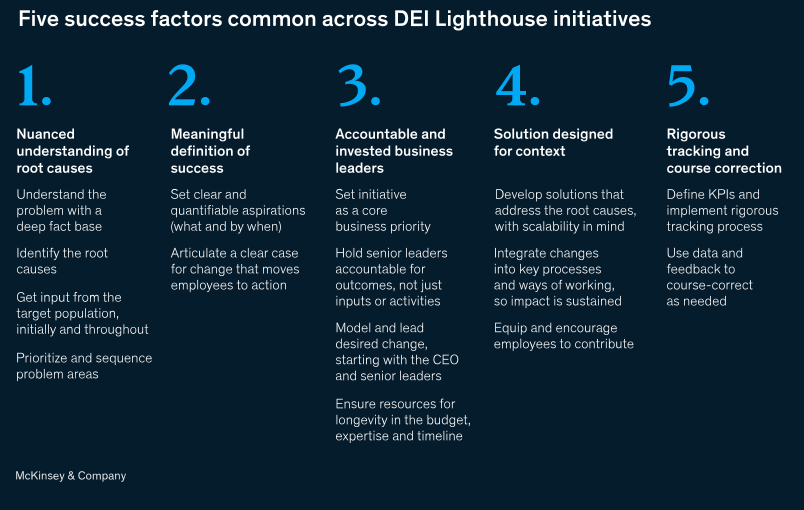
Ready to dig into DEI success factors for Lighthouse DEI? Read on for how to make them actionable for your organization.
DEI initiatives step 1: Understand the root causes
To understand what causes lack of diversity and inclusion at your company, you need to listen to your employees.
- Start with an anonymized company-wide survey that asks questions about employee experience and inclusion.
- Analyze these results in preparation for deeper conversations with individual employees
- Dig into your target areas for improvement, like a specific geography, segment, or specific identity groups in your organization.
- Uncover internal obstacles, such as organizational processes and external obstacles like cultural beliefs.
Take the time to analyze your findings and prioritize the areas for improvement. Not everything can be done at once successfully, so prioritize ease of implementation and greatest impact.
Tanmay Manohar, Paramount’s VP of People Analytics and Workforce Planning, shared how the Paramount Advertising team handled their entry-level sales associate position that had lacked diversity and had high turnover (50% after 2 years). They discovered that while diverse candidates were applying for this position, the pass-through rates were lower than they expected.
Paramount’s hiring journey audit revealed multiple challenges to hiring a diverse sales associate workforce, including:
- Starting salary was low for positions in large metro areas,
- Job requirements were misaligned, and
- Positions had narrow scope and limited growth potential.
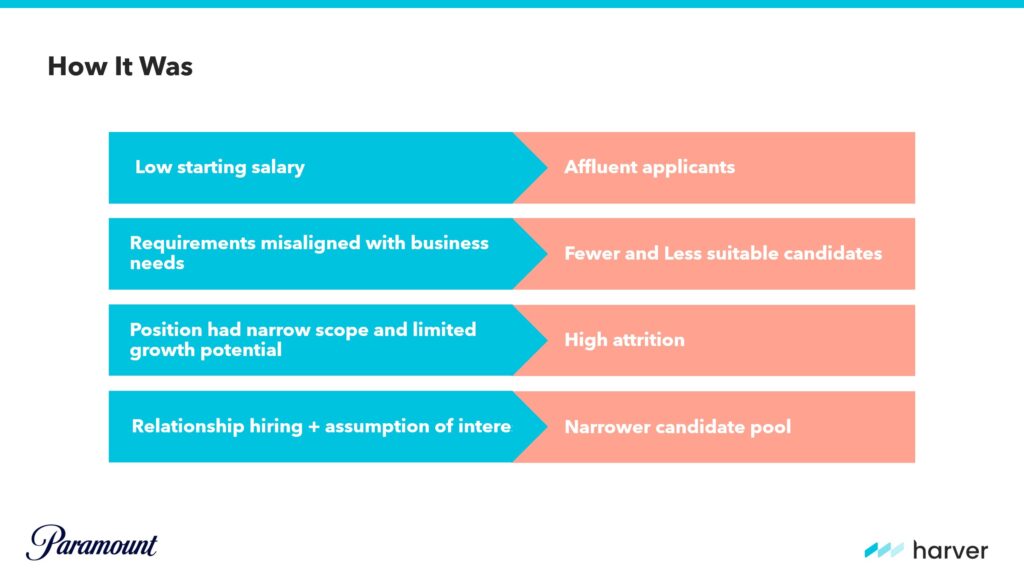
DEI initiatives step 2: Define success, meaningfully
It is important to measure DEI initiatives at work by measuring their impact instead of the activities that lead to the impact. According to the Deloitte 2023 Global Human Capital Trends survey, 23% of organizations measure progress regarding diversity commitments through adherence to compliance standards, which may focus on activities instead of the impact of those activities.
For example, setting a goal to have 10% more women in leadership positions within the next 5 years is a measurable outcome vs. participation in affinity groups. Your goals should affect the entire talent lifecycle from recruiting to internal mobility to succession planning.
Tanmay and his team set out to improve their recruiting efforts by identifying their goals and setting metrics and timelines to measure their success. Setting broad goals and KPIs (Key Performance Indicators) will help you measure the outcomes of your initiatives and monitor your progress towards those goals.
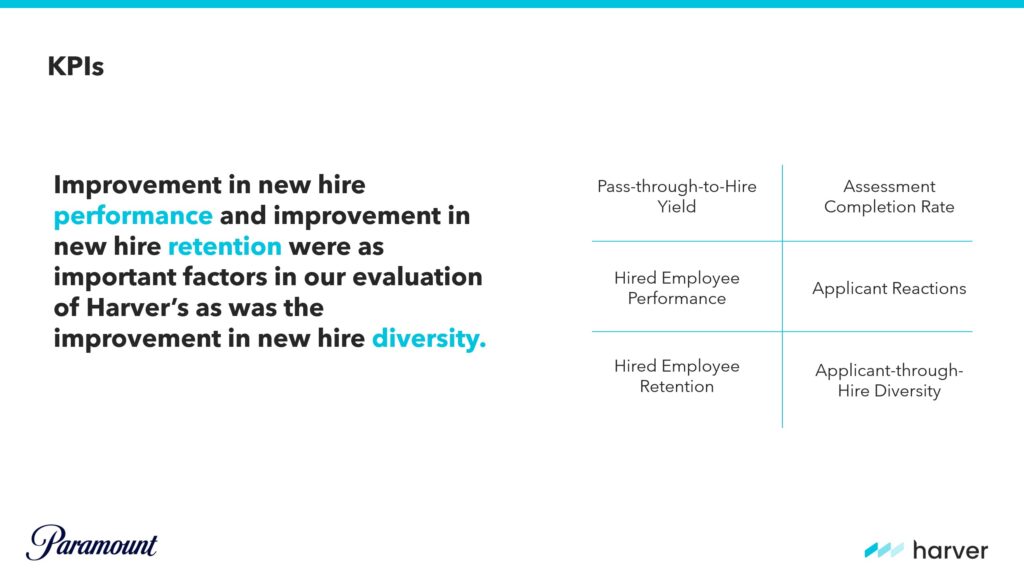
DEI initiatives step 3: Establish accountability and business leaders buy-in
Diversity, Equity, and Inclusion cannot be achieved by an individual. Successful DEI initiatives require top-down change, which means you need invested and accountable business leaders. By modeling the change you seek, these leaders can signal to employees the importance of these DEI aspirations. This also encourages employees to participate in your initiatives. Holding business leaders accountable for defined outcomes and KPI’s will ensure that the initiative will be sustainable and funded over time.
The Deloitte diversity and inclusion model below demonstrates how important it is to have a leader-led DEI strategy. Want to move from a performative DEI strategy to a holistic and effective DE&I strategy? Then check for strategy first, so you aren’t simply checking a box.
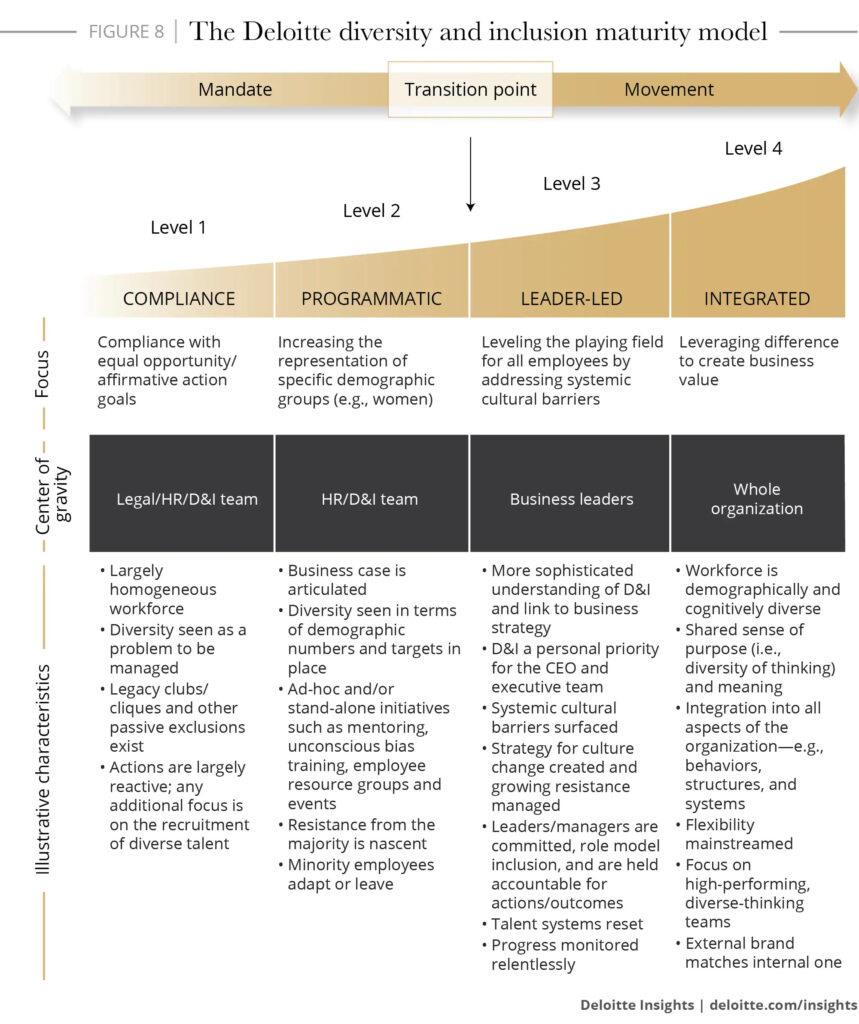
DEI initiatives step 4: Design solutions that address root causes
Effective solutions address the root causes of the lack of diversity, equity, and inclusion in your organization. These solutions should be scalable and multi-faceted, with an eye to the full talent lifecycle. For example, simply improving your recruiting process to eliminate hiring bias would be a good step. However, it wouldn’t address inequity in performance evaluations or promotional opportunities for your target population.
Scientifically validated assessments, like the solutions Harver offers, are an effective way to mitigate bias during the recruiting process. These objective evaluation methods can be used to inform development and mobility decisions within your organization, including growth areas, potential for leadership, and top talent primed for re-skilling. With Harver’s breadth of assessments, you can even customize development reports to reflect your company’s values or to create a language framework for discussing talent management.
Paramount was able to increase ethnic diversity of hires by 254% using Harver’s gamified behavioral assessments.
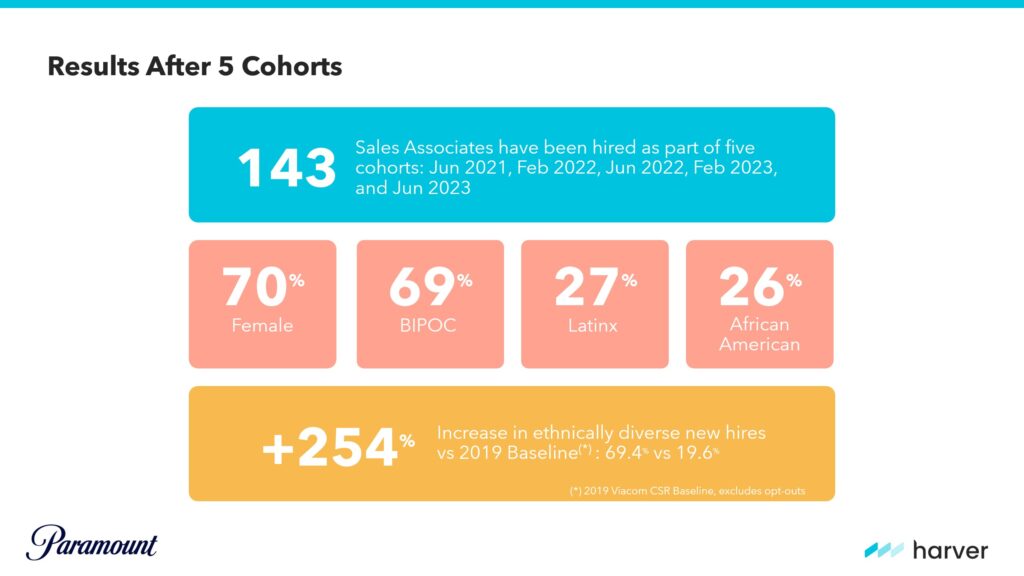
DEI initiatives step 5: Track rigorously and correct course
Measuring your progress toward KPIs allows leaders to evaluate the effectiveness of your DEI solutions. You should collect both quantitative data and qualitative data at regular intervals to ensure you are seeing the results you set out to achieve.
Harver’s business insights let you measure progress in real time so you can see where your solution is working and where you may need to course correct.
Your next step for successful DEI initiatives
Thanks to the Global Parity Alliance and McKinsey & Company, we know the five steps to a successful DEI initiative are:
- Understand the root causes of not enough diversity, equity, or inclusion
- Define success in a meaningful (and measurable) way
- Secure leadership buy-in and establish accountability
- Design solutions that tackle the root causes from step 1
- Track your metrics and use insights to continually iterate
Many organizations are still figuring out their DEI strategies and solutions. Curious about how unbiased assessments and objective talent data can support your own Lighthouse-quality DEI initiatives? Request a call with our discovery team, or explore our DEI solutions for enterprise organizations.

